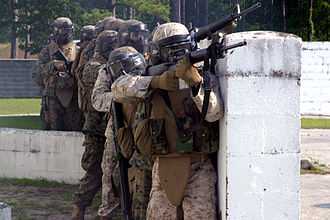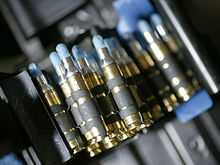Simunition

Simunition is a trademark for training ammunition produced by General Dynamics - Ordnance and Tactical Systems Canada Inc. of Québec, Canada. Simunition encompasses many types of training rounds, the best-known being the FX Marking Cartridge.
Simunition rounds are designed to be fired through police and military service weapons. Most Simunition cartridges (FX, CQT and Securiblank) require the installation of a drop-in conversion kit that does not permanently alter the weapon and can be easily removed. These kits ensure that normal service rounds cannot be fired during training and allow the use of the Simunition ammunition that work with reduced-pressure/reduced-velocity.
History
SNC Technologies Inc. (now known as General Dynamics - Ordnance and Tactical Systems Canada Inc.) created Simunition in the late 1980s with the goal of providing more realistic training to military and law enforcement agencies.
Types
FX

Invented by David Luxstone in Ottawa, Ontario, FX marking cartridges are a line of training ammunition that can be fired through standard firearms. The cartridges come in 9mm, .38 and 5.56mm calibers and fire a lead-free non-toxic reduced charge with reduced kinetic energy. To allow the weapon to cycle correctly, the top portion of the case is actually a plastic (aluminum in CQT) sabot that incorporates an inverted venturi, that upon firing springs outward, pushing the brass lower portion of the case against the bolt/slide, causing the weapon to cycle correctly in both auto and semi-auto mode.
The projectile is filled with blue, green, red, white, detergent-based, water-soluble colored marking compound and non-marking, similar to a paintball. The projectile breaks upon impact, marking the target and allowing trainers to assess the accuracy and lethality of the hits. This system is used extensively in the United States Marine Corps where it is known as SESAMS[1][2] (Special Effect Small Arms Marking System). The 5.56mm FX marking cartridges have a velocity of approximately 198 m/second,[3] as opposed to paintball guns which are generally limited to 91 m/second.
CQT
CQT Close Quarters Target Ammunition are polymer projectiles that fire using the same reduced charge sabot system as FX for reduced velocity. The advantages of CQT rounds are reduced penetration, which allows for the use of lower-cost materials in training environments and allows for close-range indoor training (see Kill House) without the need for bullet-trap systems. CQT bullets are potentially lethal and should not be fired at personnel.
Securiblank
Securiblank cartridges are blanks that can be fired through service weapons modified to fire Simunition. These blanks feature reduced pressures and noise levels.
Greenshield
Greenshield ammunition is a standard, lethal round designed to be used in indoor training ranges. The round is frangible (meaning it fractures upon impact), lead-free, and non-toxic. These are full-energy, lethal rounds not to be fired at personnel. Greenshield cartridges do not require modification to the firing weapon.
Short Stop
Short Stop training ammunition is designed for short-range training ranges where stray bullets and ricochets could be a concern. The ammunition is a full-velocity, lethal ammunition that is designed to shatter upon impact while retaining comparable recoil characteristics and accuracy out to 100 meters. This ammunition is available in a tracer variant that allows visual tracking of the round in daylight and night conditions. Short Stop ammunition does not require modification to the firing weapon.
DragonFly
DragonFly is a 40×46mm training grenade designed to be fired from military grenade launchers such as the US M203. The grenade is available in three weights (light, medium, and heavy) and comes with a reusable steel cartridge case. The round is made of inert black polymer and can be used in force-on-force training. The purpose of the DragonFly grenade is to reduce the risk of injury and the maintenance cost of a firing range by being less damaging to range infrastructure.
References
External links
- Simunition Homepage for Simunition training rounds.